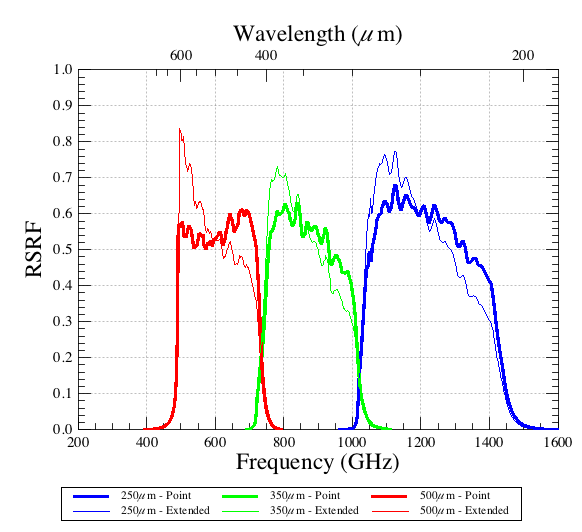






The SPIRE photometer relative spectral response functions (RSRFs) are included inside the calibration data structure that comes with every SPIRE observation.
Below is an example how to retrieve the product as a FITS binary table from an observation within HIPE. In this case the observation is located in a LocalStore pool called "od168Mars", and the file is saved in the user's local home directory under the name "SpirePhotRSRF.fits."
st1 = ProductStorage("od168Mars")
q1 = MetaQuery(herschel.spire.ia.dataset.PhotRsrf, "p", "1")
rsrf = st1.select(q1)[0].product
import os
simpleFitsWriter(product=rsrf, file=os.environ["HOME"]+"/SpirePhotRSRF.fits")
For convenience, the FITS file containing the RSRFs that was retrieved in this way is available here.
More information can be found in SPIRE Observers' Manual (here).
For a timely dissemination of information relevant to the SPIRE Photometer beam-profiles a release note was published on 21 March 2011 by the SPIRE ICC based on the analysis of scan-map observations of a bright point source (Neptune). The following supporting data is available at this FTP link:
The emprical and theoretical beam profiles are available as gzipped tarballs which contain FITS images for each filterband. The empirical beam profiles are available both for 1-arcsec pixels and nominal-sized pixels used in standard processing.
The observational data are available in form of a "g-zipped and tared" HCSS pool that can be analyzed using HIPE. Unpacking the file will result in a directory that should be moved to the local store directory of HIPE. The default location for this is ".hcss/lstore."
More information can be found in SPIRE Observers' Manual (here).
With the advent of the new V5.1 calibration product tree for SPIRE, the photometric accuracies for the photometer are now dominated by the absolute accuracy of the main calibrator Neptune of 5%. The photometric reproducibility of SPIRE is better than 2% in all bands, thus the overall calibration uncertainty that can be quoted is ±7%. The first calibration tree with this calibration has the name "spire_cal_5_1." However, it is always recommended to use the newest calibration trees that correspond to the newest version of HIPE. The newest calibration tree is named "spire_cal_9_1."
Data that are currently retrieved from the HSA has been reprocessed with HIPE 8. If no reprocessing with the newest calibration is performed, the following statements apply:
The SPIRE ICC announced on 9-Mar-2010 a re-assessment of the uncertainties for the SPIRE photometer. The original statement (PDF) from the PI Matt Griffin quotes a ±15% calibration accuracy and also re-states the need to apply the following multiplicative calibration factors to the results from the official SPIRE pipeline (for data processed with calibration versions 4 and earlier):
| Detector Name | PSW | PMW | PLW |
|---|---|---|---|
| Reference Wavelength [microns] | 250 | 350 | 500 |
| Correction Factor | 1.02 | 1.05 | 0.94 |
SPIRE flux densities are quoted for wavelengths of 250, 350 and 500 microns, based on the Herschel convention of an assumed source SED with flat nu*S(nu) (i.e., spectral index –1). Colour correction factors to convert to a different spectal index are small (a few %) and within the 15% overall error.
Read more in the Observer's manual about the Photometer Flux Calibration Scheme.